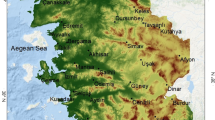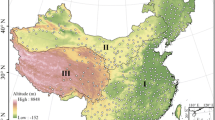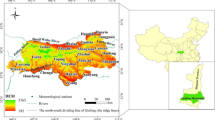Abstract
Variations of frost days and growing season length (GSL) have been drawing increasing attention due to their impact on agriculture. The Xinjiang region in China is climatically an arid region and plays an important role in agriculture development. In this study, the GSL and frost events are analyzed in both space and time, based on the daily minimum, mean and maximum air surface temperature data covering a period of 1961–2010. Results indicate that: (1) a significant lengthening of GSL is detected during 1961–2010 in Xinjiang, China. The increasing rate of GSL over Xinjiang is about 2.5 days per decade. Besides, the starting time of growing season is 0.7 days earlier per decade and the ending time is 1.6 days later per decade. Generally, GSL in southern Xinjiang has larger increasing magnitude when compared to other regions of Xinjiang; (2) longer GSL and larger changing magnitude of growing season start (GSS), growing season end (GSE) and GSL in southern Xinjiang implies higher sensitivity of the growing season response to climate warming. Besides, GSL is in close relation with latitude, and higher latitude usually corresponds to later start and earlier end of growing season, and hence shorter GSL. In general, a northward increase of 1° latitude triggers an 8-day delay of the starting time of growing season, 6-day advance of the ending time of growing season, and thus the GSL is 14 days shorter; (3) GSL under different rates can reflect light and heat resources over Xinjiang. The GSL related to 80 % guarantee rate is 5–14 days shorter than the long-term annual mean GSL; (4) Lengthening of GSL has the potential to increase agricultural production. However, negative influences by climate warming, such as enhanced evapotranspiration, increasing weeds, insects, and pathogen-mediated plant diseases, should also be considered in planning, management and development of agriculture in Xinjiang.








Similar content being viewed by others
References
ACIA (2004) Impacts of a warming arctic: arctic climate impact assessment. Cambridge University Press, Cambridge, p 140
Anandhi A, Perumal S, Gowda PH, Knapp M, Hutchinson S, Harrington J Jr, Murray L, Kirkham MB, Rice CW (2013) Long-term spatial and temporal trends in frost indices in Kansas, USA. Clim Change 120:169–181
Ansndhi A, Zion MS, Gowda PH (2013) Past and future changes in frost day indices in Catskill Mountain region of New York. Hydrol Process 27:3094–3104
Ayvaz MT, Karahan H, Aral MM (2007) Aquifer parameter and zone structure estimation using kernel-based fuzzy c-means clustering and genetic algorithm. J Hydrol 343(4):240–253
Bonsal BR, Zhang X, Vincent LA, Hogg WD (2001) Characteristics of daily and extreme temperatures over Canada. J Clim 14:1959–1976
Christidis N, Stott PA, Brown S, Karoly DJ, Caesar J (2007) Human contribution to the lengthening of the growing season during 1950–99. J Clim 20(21):5441–5454
Daufresne M, Lengfellner K, Sommer U (2009) Global warming benefits the small in aquatic ecosystems. Proceed Nat Acad Sci USA 106(31):12788–12793
Davis NE (1972) The variability of the onset of spring in Britain. Quart J Royal Meteorol Soc 98(418):763–777
Easterling RD (2002) Recent changes in frost days and the frost-free season in the United States. Bull Am Meteorol Soc 83:1327–1332
Frich P, Alexander LV, Della-Marta P, Gleason B, Haylock M, Klein Tank AMG, Peterson T (2002) Observed coherent changes in climatic extremes during the second half of the twentieth century. Clim Res 19:193–212
Hamed KH, Rao AR (1998) A modified Mann–Kendall trend test for autocorrelated data. J Hydrol 204(1–4):182–196
Heino R, Brázdil R, Førland E, Tuomenvirta H, Alexandersson H, Beniston M, Pfister C, Rebetez M, Rosenhagen G, Rösner S, Wibig J (1999) Progress in the study of climate extremes in northern and central Europe. Clim Change 42:151–181
Hollander M, Wolfe DA, Chicken E (1973) Nonparametric statistical methods. Wiley, New York
IPCC (2007) In Climate Change 2007: The physical science basis. In: Solomon S, Qin D, Manning M, Chen Z, Marquis M, Averyt KB, Tignor M, Miller HL (eds) Contribution of working Group I to the fourth assessment report of the intergovernmental panel on climate change. Cambridge University Press: Cambridge, New York, p 996
Jiang FQ, Li XM, Wei BG, Hu RJ, Li Z (2009) Observed trends of heating and cooling degree-days in Xinjiang Province, China. Theor Appl Climatol 97(3–4):349–360
Jylhä K, Fronzek S, Tuomenvirta H, Carter RT, Ruosteenoja K (2008) Changes in frost, snow and Baltic sea ice by the end of the twenty-first century based on climate model projections for Europe. Clim Change 86:441–462
Kadioglu M, Sen ZK, Gültekin L (2001) Variations and trends in Turkish seasonal heating and cooling degree-days. Clim Change 49:209–223
Kendall MG (1955) Rank correlation methods. Griffin, London
Kunkel KE, Easterling RD, Redmond K, Hubbard K (2003) Temporal variations of extreme precipitation events in the United States: 1895–2000. Geophys Res Lett 30:1900
Linderholm HW, Walther A, Chen D (2008) Twentieth-century trends in the thermal growing season in the Greater Baltic Area. Clim Change 87:405–419
Liu BH, Henderson M, Xu M (2008) Spatiotemporal change in China’s frost days and frost-free season, 1955–2000. J Geophys Res 113:D12104
Mann HB (1945) Nonparametric tests against trend. Econometrica 13:245–259
Meehl GA, Tebaldi C, Nychka D (2004) Changes in frost days in simulations of twenty first century climate. Clim Dyn 23(5):495–511
Menzel A, Jakobi G, Ahas R, Scheifinger H, Estrella N (2003) Variations of the climatological growing season (1951-2000) in Germany compared with other countries. Int J Climatol 23:793–812
Mitchell JM, Dzerdzeevskii B, Flohn H (1966) Climate change, WHO technical note 79. World Meteorological Organization, Geneva 79
Parmesan C, Yohe G (2003) A globally coherent fingerprint of climate impacts across natural systems. Nature 421:37–42
Patterson DT, Westbrook JK, Joyce RJV, Rogasik J (1999) Weeds, insects, and diseases. Clim Change 43:711–727
Qian B, Gameda S, Zhang X, Jong DR (2012) Changing growing season observed in Canada. Clim Change 112:339–353
Rahimi M, Hajjam S, Khalili A, Kamali AG, Stigter JC (2007) Short communication risk analysis of first and last frost occurrences in the Central Alborz Region, Iran. Int J Climatol 27:349–356
Robeson SM (2002) Increasing growing-season length in Illinois during the 20th century. Clim Change 52:219–238
Root TL, Price JT, Hall KR, Schneider SH, Rosenzweig C, Pounds JA (2003) Fingerprints of global warming on wild animals and plants. Nature 421:57–60
Sammon JW Jr (1969) A nonlinear mapping for data structure analysis. IEEE Trans Comput 18:401–409
Schwartz MD, Chen X (2002) Examining the onset of spring in China. Clim Res 21:157–164
Schwartz MD, Rein A, Anto A (2006) Onset of spring starting earlier across the northern hemisphere. Glob Change Biol 12:343–351
Sen PK (1968) Estimates of the regression coefficient based on Kendall’s tau. J Am Stat Assoc 63:1379–1389
Sohrabi MM, Ryu HJ, Abatzoglou J, Tracy J (2013) Climate extreme and its linkage to regional drought over Idaho, USA. Natural Hazards 65(1):653–681
Song YL, Linderholm WH, Chen DL, Walther A (2010) Trends of the thermal growing season in China, 1951–2007. Int J Climatol 30:33–43
Sprent P, Smeeton NC (2007) Applied nonparametric statistical methods. CRC Press
Theil H (1950) A rank invariant method for linear and polynomial regression analysis. Nederlandse Akademie van Weinensch Proc Series A 53:386–392 (Part I), 521–525 (Part II), 1397–1412 (Part III)
Walther A, Linderholm HW (2006) A comparison of growing season indices for the Greater Baltic Area. Int J Biometeorol 51:107–118
Walther A, Chen D, Linderholm H, Song Y (2010) Trends of the thermal growing season in China, 1951–2007. Int J Climatol 30:33–43
Wang J, Xu DY, Gao YJ (2006) Dominant fruits and climate in Xinjiang. Meteorological Press, Beijing (in Chinese)
White MA, Running SW, Thornton PE (1999) The impact of growing season length variability on carbon assimilation and evapotranspiration over 88 years in the eastern US deciduous forest. Int J Biometeorol 42:139–145
Xu DY (1989) Planning and climate resources for agriculture in Xinjiang. Meteorological Press, Beijing (in Chinese)
Zhang Q, Li JF, Chen YD, Chen XH (2011a) Observed changes of temperature extremes during 1960–2005 in China: natural or human-induced variations? Theoret Appl Climatol 106(3–4):417–431
Zhang Q, Singh VP, Li JF, Chen XH (2011b) Analysis of the periods of maximum consecutive wet days in China. J Geophys Res 116:D23106
Zhang Q, Qi TY, Li JF, Singh VP, Wang ZZH (2014) Spatiotemporal variations of pan evaporation in China during 1960-2005: changing patterns and causes. Int J Climatol 35(6):903–912
Acknowledgments
This work was financially supported by the Xinjiang Science and Technology Planning Project (Grant No. 201331104), the National Science Foundation for Distinguished Young Scholars of China (Grant No. 51425903), the Leading Expert Project by Anhui Province and fully supported by a grant from the Research Grants Council of the Hong Kong Special Administrative Region, China (Project No. CUHK441313). Our cordial gratitude will be extended to the editor, Prof. Dr. Rob Roebeling, and two anonymous reviewers for their professional and pertinent comments and suggestions, which are greatly helpful for further improvement of the quality of this manuscript.
Author information
Authors and Affiliations
Corresponding author
Additional information
Responsible Editor: R. Roebeling.
Rights and permissions
About this article
Cite this article
Ci, H., Zhang, Q., Singh, V.P. et al. Spatiotemporal properties of growing season indices during 1961–2010 and possible association with agroclimatological regionalization of dominant crops in Xinjiang, China. Meteorol Atmos Phys 128, 513–524 (2016). https://doi.org/10.1007/s00703-015-0419-8
Received:
Accepted:
Published:
Issue Date:
DOI: https://doi.org/10.1007/s00703-015-0419-8




